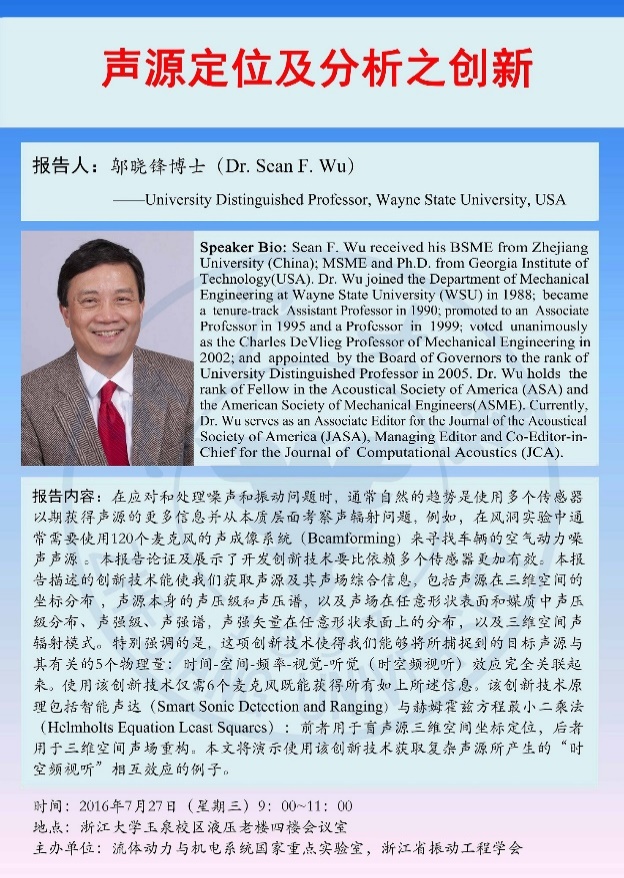Academic Report:Innovation of Sound Source Location and Analysis
Time:2016.7.27 9:00AM~11:00AM
Location:Conference Room, 4th Floor, Hydraulic Old Building, Yuquan Campus

Abstract:
When dealing with noise and vibration problems, it is often natural to use multiple sensors in order to obtain more information about the sound source and to examine the acoustic radiation problem from an essential level. For example, in a wind tunnel experiment, 120 microphones are usually required. Sound imaging system (Beamforming) to find the aerodynamic noise source of the vehicle. This report demonstrates and demonstrates that developing innovative technologies is more effective than relying on multiple sensors. The innovative techniques described in this report enable us to obtain comprehensive information on the sound source and its sound field, including the coordinate distribution of the sound source in three dimensions, the sound pressure level and sound pressure spectrum of the sound source itself, and the sound field in any shape surface and medium. Pressure distribution, sound intensity level, sound intensity spectrum, distribution of sound intensity vector on any shape surface, and three-dimensional spatial sound radiation pattern. In particular, this innovative technology allows us to fully correlate the captured target sound source with its five physical quantities: time-space-frequency-visual-audio (time-space-frequency audiovisual) effects. With this innovative technology, only six microphones are required to obtain all of the information described above. The innovative technology principles include Smart Sonic Detection and Ranging and Helmholts Equation Least Squares: the former is used for three-dimensional spatial coordinate localization of blind sound sources, and the latter is used for three-dimensional spatial sound field weight. Structure. This article will demonstrate an example of the “space-time-frequency audiovisual” interaction produced by this innovative technology for complex sound sources.
Brief Bio:
Sean F. Wu received his BSME from Zhejiang University (China); MSME and Ph.D. from Georgia Institute of Technology (USA). Dr. Wu joined the Department of Mechanical Engineering at Wayne State University (WSU) in 1988; became a tenure-track Assistant Professor in 1990; promoted to an Associate Professor in 1995 and a Professor in 1999; voted unanimously as the Charles DeVlieg Professor of Mechanical Engineering in 2002; and appointed by the Board of Governors to the rank of University Distinguished Professor in 2005. Dr. Wu holds the rank of Fellow in the Acoustical Society of America (ASA) and the American Society of Mechanical Engineers (ASME). Currently, Dr. Wu serves as an Associate Editor for the Journal of the Acoustical Society of America (JASA), Managing Editor and Co-Editor-in-Chief for the Journal of Computational Acoustics (JCA).

